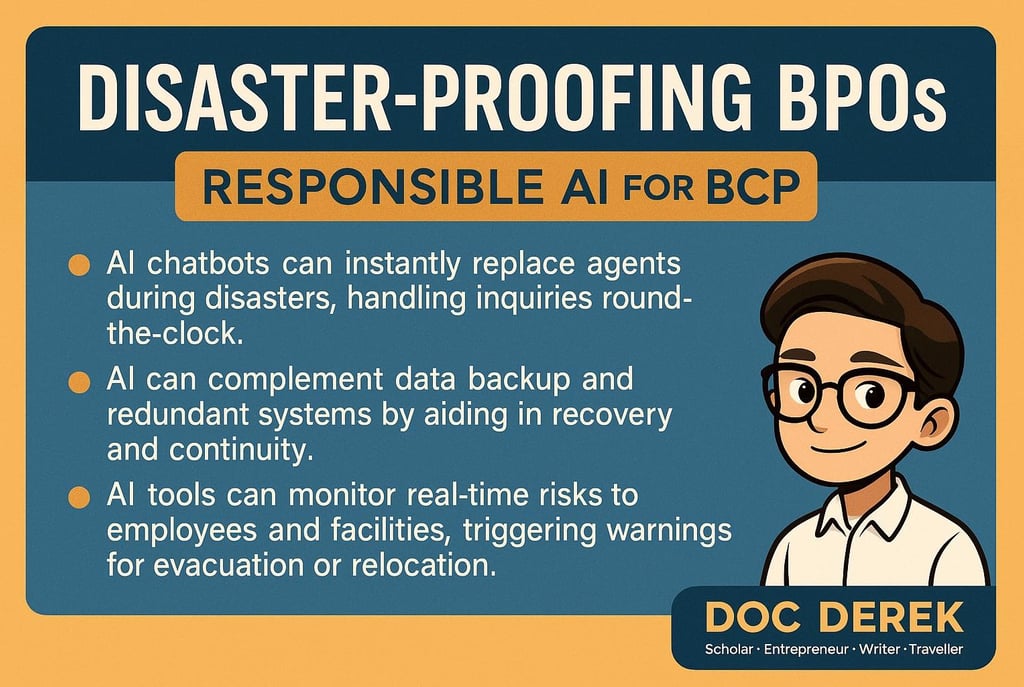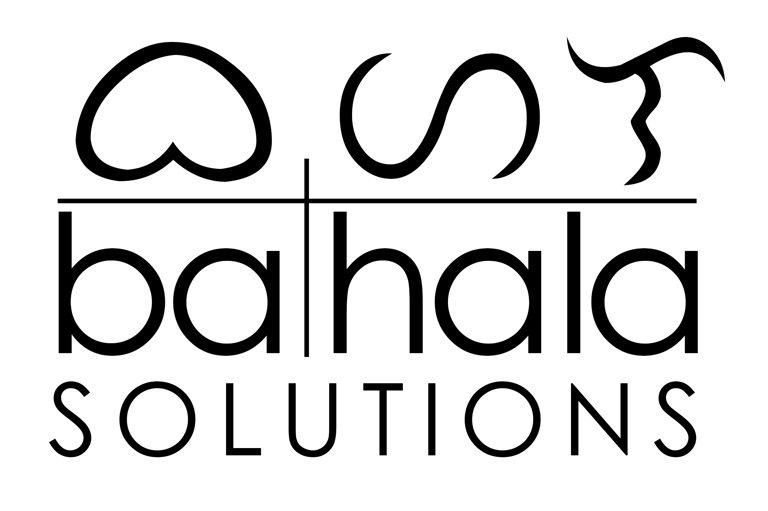Artificial Intelligence and Business Continuity in the Philippine BPO Industry: Lessons from the Cebu Earthquake
This paper examines how the 2025 Cebu earthquake exposed critical flaws in Philippine BPO companies’ business continuity plans—particularly the prioritization of service-level agreements over employee safety—and argues that integrating artificial intelligence (e.g., chatbots, cloud-based disaster routing, AI copilots) can enhance resilience while safeguarding workers, aligning with global standards like ISO 22301 and Philippine OSH laws.
BUSINESS CONTINUITY PLAN (BCP)ARTIFICIAL INTELLIGENCE (AI)PHYSICAL SECURITY
Dr. Derek Presto
10/3/20256 min read


Abstract
The Philippines, the global leader in voice-based business process outsourcing (BPO), faces persistent risks from natural disasters due to its geographic location in the Pacific Ring of Fire. On September 30, 2025, a 6.9-magnitude earthquake struck Cebu, exposing gaps in the industry’s business continuity planning (BCP). Allegations surfaced that some BPO companies forced employees to remain on calls during the quake and obstructed exit routes, leading to complaints filed with the Department of Labor and Employment (DOLE). This incident underscores the tension between fulfilling service-level agreements (SLAs) and ensuring employee safety.
This paper examines the Cebu case as a critical turning point for the Philippine BPO sector. It situates the incident within existing occupational safety and health (OSH) laws and global continuity standards such as ISO 22301 and NIST 800-34. Drawing from global case studies, the paper explores how artificial intelligence (AI) can strengthen continuity by automating client-facing functions during disasters, reducing human exposure, and supporting rapid recovery. It argues that integrating AI into continuity frameworks is essential for balancing client demands with worker welfare, ensuring resilience, and preserving the industry’s global competitiveness.
Introduction
The Philippine business process outsourcing (BPO) industry employs over 1.3 million workers and contributes approximately 7.5% to the country’s gross domestic product (IBPAP, 2023). It has positioned itself as the world’s largest provider of voice-based services, competing on cost efficiency, cultural affinity, and English proficiency. However, the Philippines’ vulnerability to natural disasters—typhoons, earthquakes, volcanic eruptions—creates inherent risks to the industry’s continuity.
On September 30, 2025, a 6.9-magnitude earthquake hit Cebu, one of the country’s major IT-BPM hubs. The tremor caused severe damage to infrastructure, power, and communications, with at least 69 fatalities and over 150 injuries reported (Reuters, 2025; Washington Post, 2025). More controversially, reports emerged that some BPO companies allegedly required employees to continue taking calls during the quake, and one office floor had blocked exits (CDN Digital, 2025). The BPO Industry Employees Network (BIEN Cebu) announced it would file a complaint with DOLE, raising questions about labor rights, OSH compliance, and the adequacy of continuity planning.
This paper investigates the Cebu case as an entry point into a broader question: how can AI be integrated into BPO operations to ensure resilience without sacrificing employee safety? By situating the incident within the Philippine regulatory framework and global standards, it highlights both the failures of current BCPs and the opportunities of AI-driven solutions.
Literature Review
Business Continuity Planning (BCP) in Service Industries
Business continuity planning is a governance framework ensuring that organizations can continue critical operations despite disruptions (Cerullo & Cerullo, 2004). ISO 22301 defines continuity as an integrated system involving hazard assessment, recovery time objectives (RTOs), crisis communication, and employee welfare (ISO, 2019). In service industries like BPO, where human capital is the primary driver, continuity often collides with workforce safety.
Cerullo and Cerullo (2004) emphasize that continuity must balance financial losses with human impact. Studies from India’s IT-BPM sector show that firms with poor evacuation practices but strong redundancy systems tend to maintain SLAs at the expense of employee safety (Kapur & Ramamurthy, 2018). Latin American call centers, particularly in Mexico and Chile, similarly highlight “operational resilience gaps” where drills are irregular and alternate work sites poorly resourced (CEPAL, 2020).
Disaster Vulnerability in the Philippines
The Philippines ranks among the most disaster-prone countries in the world (World Bank, 2021). Its geographic location within the Pacific Ring of Fire makes earthquakes common. The 2013 Bohol quake and 1990 Luzon quake disrupted local economies and underscored the need for BCP mainstreaming. The National Disaster Risk Reduction and Management Plan (NDRRMP) 2020–2030 mandates organizations to integrate risk reduction and continuity, but enforcement has been inconsistent (NDRRMC, 2020).
AI in Service Resilience
AI adoption in business continuity is still emerging. Studies show that conversational AI systems, such as chatbots and virtual agents, have been used to absorb call volumes during crises, notably during the COVID-19 pandemic (WHO, 2020). Gartner (2023) projects that by 2026, 60% of customer service interactions will involve AI assistance. AI supports continuity by (a) deflecting routine inquiries, (b) rerouting workflows via cloud platforms, and (c) supporting human agents with AI copilots upon return (McKinsey, 2023).
In BPO-specific contexts, Genesys (2023) and AWS (2020) highlight how disaster recovery (DR) routing can automatically divert inbound calls to bots or global alternate centers. Dialogflow case studies show crisis bots handling multilingual queries for universities and governments during emergencies (Google Cloud, 2023).
Gaps in Literature
While AI’s role in resilience is widely studied in healthcare, finance, and government, there is little empirical research on AI for continuity in the Philippine BPO industry. The Cebu quake thus provides a unique case for theorizing AI’s role in bridging safety and continuity.
Legal and Regulatory Context
The Cebu case must be examined within Philippine law:
R.A. 11058 (OSH Law): Grants workers the right to refuse unsafe work in “imminent danger” (LawPhil, 2018).
DOLE Department Order 198-18: Requires evacuation protocols and empowers safety officers to halt operations (DOLE, 2018).
R.A. 9514 (Fire Code): Explicitly prohibits blocking exits (LawPhil, 2008).
R.A. 10121 (DRRM Act): Requires mainstreaming risk reduction and continuity (NDRRMC, 2020).
If proven, forcing employees to stay on calls during an earthquake constitutes not only negligence but possible OSH violations.
The Cebu Earthquake Case
The earthquake highlighted the following failures:
Over-prioritization of SLAs: “Keep the lines live” culture overrode evacuation.
Blocked exits: Direct Fire Code violation.
No alternate sites: Reliance on a single hub disrupted operations.
No mass communication: Employees were not uniformly instructed to evacuate.
For an industry that prides itself on global reliability, these failures risk reputational damage with international clients, who may reconsider outsourcing to regions perceived as unsafe.
AI Integration Pathways for BPOs
AI Chatbots and Virtual Agents
Conversational AI can manage FAQs, intake, and triage during crises (WHO, 2020; Google Cloud, 2023). Instead of forcing humans to stay online during tremors, virtual agents can temporarily absorb client interactions.
Cloud-Based DR Routing
Cloud platforms like Genesys Cloud and Amazon Connect offer disaster recovery routing, enabling automatic traffic rerouting to alternate centers or bot workflows (AWS, 2020; Genesys, 2023).
AI-Powered Crisis Notifications
AI-enabled notification systems can send multilingual alerts to employees, ensuring coordinated evacuation (ITU, 2022).
AI Copilots for Recovery
Generative AI copilots can help returning workers quickly resume by summarizing missed calls, retrieving data, and reducing post-disaster stress (McKinsey, 2023).
Predictive Analytics
AI can model seismic risks and supply chain disruptions, aiding proactive workforce relocation (PwC, 2022).
Global Comparative Insights
India: BPO hubs in Bangalore use AI bots for call deflection during floods (Kapur & Ramamurthy, 2018).
Mexico: After the 2017 Puebla quake, call centers adopted hybrid human-AI continuity strategies (CEPAL, 2020).
Japan: AI systems assist disaster recovery planning in financial services, balancing SLAs with workforce evacuation (Fujitsu, 2021).
Policy and Industry Implications
For Regulators (DOLE, DICT, NDRRMC): Require AI-integrated BCP audits; penalize firms prioritizing SLAs over safety.
For Industry (IBPAP, PEZA): Create AI-BCP guidelines and share best practices.
For Clients: Demand force majeure clauses that allow automation fallback.
For Workers: Training in AI tools and guaranteed OSH protections.
Conclusion
The Cebu earthquake is a wake-up call. It revealed that traditional BCPs in Philippine BPOs are insufficient when human safety is compromised for SLA obligations. Integrating AI into BCP provides a path forward: automation absorbs workloads, cloud reroutes maintain service, and workers are evacuated safely. The Philippine BPO sector must now move from reactive continuity to proactive, AI-enabled resilience to remain globally competitive and ethically responsible.
References
AWS. (2020). Disaster recovery options in the cloud. Amazon Web Services. https://docs.aws.amazon.com/whitepapers/latest/disaster-recovery-workloads-on-aws/disaster-recovery-options-in-the-cloud.html
CDN Digital. (2025, October 2). BPO employees set to file complaint against BPO companies. https://www.facebook.com/cdndigital/posts/1220598536766822/
Cerullo, V., & Cerullo, M. (2004). Business continuity planning: A comprehensive approach. Information Systems Management, 21(3), 70–78. https://doi.org/10.1201/1078/44432.21.3.20040601/82474.9
Department of Labor and Employment [DOLE]. (2018). Implementing rules and regulations of R.A. 11058. Bureau of Working Conditions. https://cda.gov.ph/wp-content/uploads/2019/07/coopsday-DOLE-Bureau-of-Working-Conditions.pdf
Fujitsu. (2021). AI in disaster resilience. Fujitsu Research Institute.
Genesys. (2023). Business continuity guide. Genesys Cloud CX. https://developer.genesys.cloud/platform/integrations/guides/business-continuity-guide
Google Cloud. (2023). Dialogflow case studies. https://cloud.google.com/dialogflow/docs/case-studies
International Organization for Standardization [ISO]. (2019). ISO 22301: Security and resilience – Business continuity management systems. ISO. https://www.iso.org/standard/75106.html
International Telecommunication Union [ITU]. (2022). AI for disaster management. ITU Reports.
LawPhil. (2008). Republic Act No. 9514: Fire Code of the Philippines. https://lawphil.net/statutes/repacts/ra2008/ra_9514_2008.html
LawPhil. (2018). Republic Act No. 11058: OSH law. https://lawphil.net/statutes/repacts/ra2018/ra_11058_2018.html
McKinsey & Company. (2023). The economic potential of generative AI: The next productivity frontier. https://www.mckinsey.com/capabilities/mckinsey-digital/our-insights/the-economic-potential-of-generative-ai
National Disaster Risk Reduction and Management Council [NDRRMC]. (2020). Philippine National Disaster Risk Reduction and Management Plan 2020–2030. https://www.preventionweb.net/publication/philippines-national-disaster-risk-reduction-and-management-plan-2020-2030
National Institute of Standards and Technology [NIST]. (2010). Contingency planning guide for federal information systems (SP 800-34 Rev. 1). U.S. Department of Commerce. https://csrc.nist.gov/pubs/sp/800/34/r1/upd1/final
PwC. (2022). Future of resilience: Predictive analytics for risk management. PwC Global Report.
Reuters. (2025, October 1). Death toll from Cebu earthquake rises to 69. https://www.reuters.com/business/environment/death-toll-philippines-earthquake-rises-60-official-says-2025-10-01
Washington Post. (2025, September 30). Philippines earthquake devastates Cebu. https://www.washingtonpost.com/climate-environment/2025/09/30/philippines-earthquake-cebu-bogo/
World Bank. (2021). Philippines country climate and disaster risk profile. World Bank Group.
World Health Organization [WHO]. (2020). How chatbots are helping in COVID-19 response. https://www.who.int/news-room/feature-stories/detail/scicom-compilation-chatbot
Contact
contact@bathalasolutions.com
